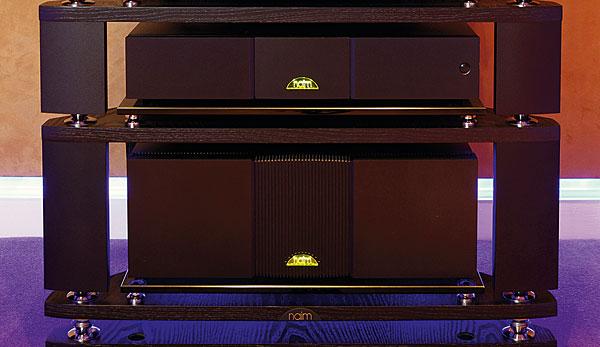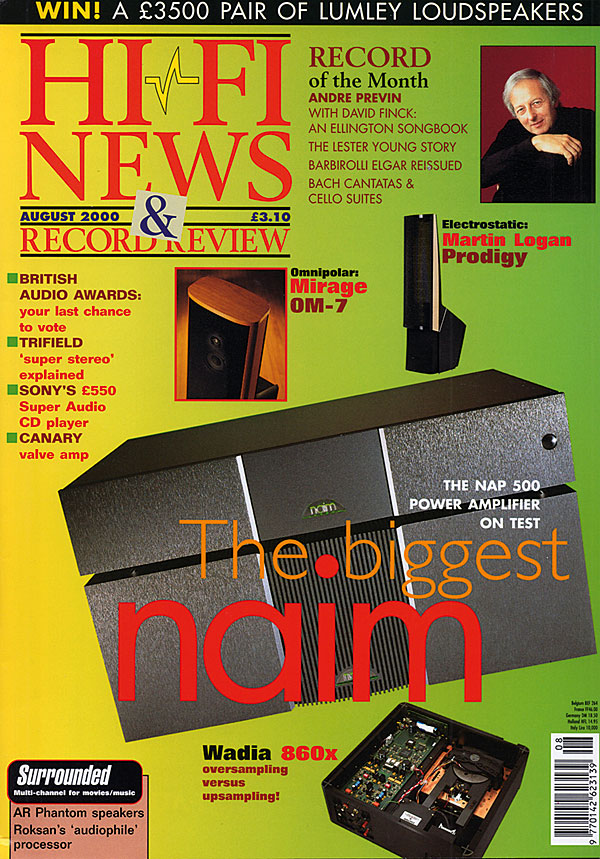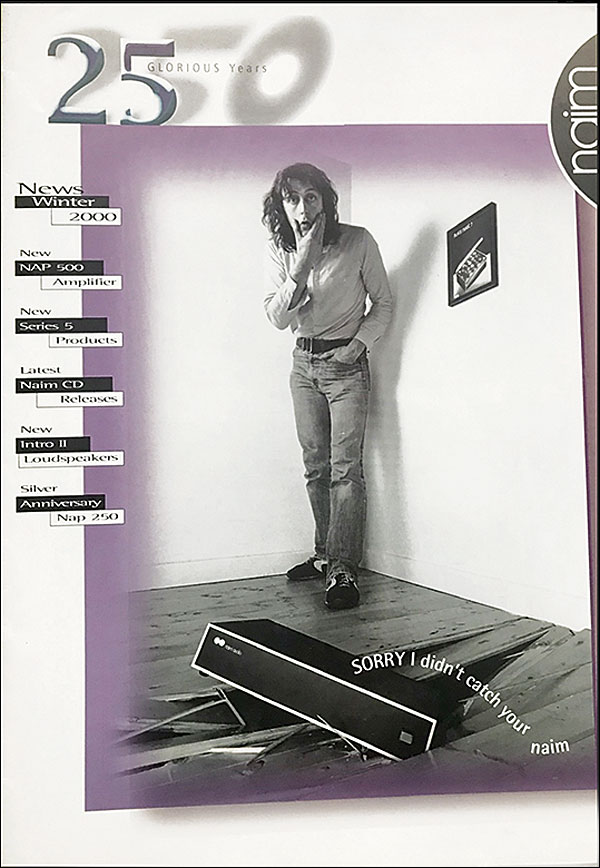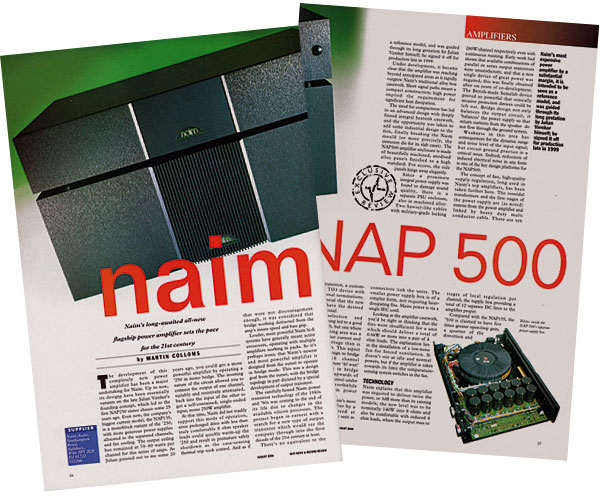Naim NAP 500 power amp

 Martin Colloms hears a power amp setting the pace for the 21st century
Martin Colloms hears a power amp setting the pace for the 21st century
The development of this completely new power amplifier has been a major undertaking for Naim. Up to now, its designs have been variants on the late Julian Vereker's founding concept, which led to the first NAP 250 stereo chassis some 25 years ago. Even now, the company's biggest current model, the NAP 135, is a monoblock variant of the '250, with more generous power supplies allocated to the separated channels.
Take It To The Bridge
The output ceiling has remained at 70-80W per channel for this series of amps. As Julian pointed out to me some 20 years ago, you could get a more powerful amp by operating a '250 in mono bridge. The inverting nature of the circuit allowed you to connect the output of one channel, suitably and resistively attenuated, back into the input of the other to get a self-contained, single-ended input, mono 250W amplifier.

At that time, Naim did not readily support this mode of operation, since prolonged drive with less than truly comfortable 8ohm speaker loads could quickly warm-up the '250 and result in premature safety shutdown as the case-sensing thermal trip took control. And as if that were not discouragement enough, it was considered that bridge working detracted from the amp's innate speed and bass grip.
Louder, more powerful Naim hi-fi systems have generally meant active crossovers, operating with multiple amps working in packs. So it's perhaps ironic that Naim's newest and most powerful amplifier is designed to operate in bridge mode. This was a design goal from the outset, with the bridge topology in part dictated by a special development of the output transistor used.
The carefully-honed Naim power transistor technology of the 1980s and '90s was coming to the end of its life due to changes in the available silicon processes. The project began in earnest with a search for a new type of output transistor which would see the company through into the first decade of the 21st century at least.
Current Concerns
There's no equivalent to the original Naim transistor, a custom-built very fast TO3 device with heavy-duty internal terminations. And it was essential that the new device should have the desired sound quality potential. Exhaustive selection and subsequent fine-tuning led to a good choice from the company Semelab, but one where the favoured operating area was a combination of higher current and lower operating voltage than is customary these days.
This aspect primarily drove the design to bridge mode, where each channel comprises two high-current '40 watt' amplifiers operating in bridge differential. There's upwards of 150W of power per channel under normal conditions: a worthwhile gain of some 4dB in power headroom over a NAP 135.

The need for compactness has led to a design with deeply finned integral heatsink casework, and the opportunity was taken to add some industrial design to the mix, finally breaking the Naim mould (or more precisely, the extrusion die for its slab cases). The NAP 500 enclosure is made of beautifully machined, anodised alloy panels finished to a high standard. For access, the side panels hinge away elegantly.
Since a proximate integral power supply was found to damage sound quality, there is a separate PSU enclosure, also in machined alloy. Two hawser-like cables with military-grade locking connectors link the units. The smaller power supply box is of a simpler form, not requiring heat-dissipating fins, while mains power is via a single IEC cord.
Looking at the casework, you'd be right in thinking the fins were insufficient for a unit that should deliver 0.6kW or more into a pair of 4ohm loads. The explanation lies in the installation of a fan for forced ventilation. If the amp is taken towards its limit, a temperature-sensing system switches this in.
The Technology
Naim explains that this amplifier was required to deliver twice the power, or 3dB more than its existing models. The new level was to be nominally 140W into 8ohm and also be comfortable with reduced 4ohm loads, where the output rises to 280W/channel respectively even with continuous running. Early work had shown that available combinations of parallel or series output transistors were unsatisfactory for this purpose, and that a new single device of great power was required. This was finally obtained after six years of co-development.
In fact, the British-made Semelab device proved so powerful that sonically invasive protection devices could be left out. Bridge design not only balances the output circuit, it 'balances' the power supply so that return currents from the loudspeaker do not flow through the ground system.
Weakness in this area has consequences for the dynamic range and noise level of the input signal, but circuit ground practice is a critical issue. Indeed, reduction of induced electrical noise in any form is one of the key design platforms for the NAP 500.
The concept of fast, high-quality supply regulation, long used in Naim's top amplifiers, has been taken further here. The toroidal transformers and the first stages of the power supply are (as noted earlier) remote from the power amplifier. There are ten stages of local regulation per channel, the supply box providing a total of 12 separate DC lines to the amplifier proper. Compared with the NAP 135, the '500 is claimed to have five times greater open-loop gain, a quarter of the distortion and a dynamic noise floor that is 100 times reduced.

Specification claims for this fully regulated power amp are: greater than 140W per channel into 8ohm; voltage gain 29dB; a modest input impedance of 18kohm; a 1.5Hz to 100kHz frequency response (limits unspecified); and an economical 60VA idle power. A 29dB gain is close on 30 times, so a CD player's 2V output can give '60V' from the amplifier. This means the NAP 500 will operate successfully with a passive line controller.
Internal build quality is excellent throughout and, as with its predecessors, as much design thought and care has been lavished on the high-speed, low-coloration regulated supplies as on the power amplifiers themselves. The power unit has a single 1.2kVA toroid specially built to Naim's specifications for both sound quality and minimal mechanical noise, which is often a problem with good-sounding toroids. Meanwhile, separated secondary windings feed the two channels.
Armed with the powerful, discrete circuitry buffer amplifier developed for the CDS II CD player, Naim chose an unusual route to create the balanced signal internally for bridge mode. Instead of using a bi-phase stage, one section of the bridge amplifier is operated as a shunt feedback current input, the other in voltage mode, so generating the required balanced phase across to output terminals. In overall concept, the amplifier is actually constructed as two mono amps in one main enclosure.
A Touch Of Spice
The CAD modelling was so accurate that the company has been able to remove pre-set components, eg, for bias, which have a finite reliability. In production, the amps are set up, then instead of the previous pre-set components, aligned and selected resistors are soldered in place. The result is both an improvement in sound quality and long-term reliability.
























































